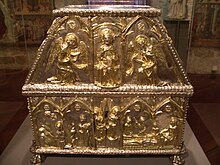Cucuphas

Saint Cucuphas (also Cucufas or Qaqophas ; Catalan : Cugat, Culgat or Cougat , Spanish : Cucufate, Cucufato or Cocoba (s) , French : Cucuphat, Cucufa, Cucuphat or Quiquenfat , Galician : Covade or Cobad , Occitan : Cophan , Asturian : Cucao ) is an early Christian martyr and saint. The exact dates of his life are unknown - sometimes his year of birth is given as 269 or 270 and his year of death as 303 or 304.
life and death
According to tradition, it came from Scilium in North Africa; he was with St. Felix came to Barcelona at the beginning of the 4th century to evangelize the region. He was generous to the poor and worked miracles. In 304 he was martyred in the course of the Diocletian persecution of Christians near Barcelona. Two Christian women, Juliana and Semproniana , buried his body and died as martyrs for it. The Benedictine monastery of Sant Cugat del Vallès was later built over his grave .
Another legend adorns his martyrdom with incredible details: He is said to have been handed over to twelve soldiers who flogged him and battered his skin with iron nails and scorpions . He was placed alive in a barrel with pepper and vinegar ; then he was grilled, but a heavenly power saved him from death. Burning at a stake could not kill him either, but it did kill some of the soldiers ... He was thrown into prison, where some of his guards were converted to the Christian faith by a light in his cell. The torture continued the next day; Prefect Maximinianus' car caught fire and he himself burned. Thereupon the new Prefect Rufus ordered the immediate beheading of Cucuphas with the sword.
Adoration
Cucuphas is mentioned in the Martyrologium Hieronymianum and in other writings from the Middle Ages. His feast day is the 25th or - depending on the region - the 27th of July. His relics are kept in the monastery of Sant Cugat del Vallès ; Parts are said to have found their way to the former abbey church of Saint-Denis near Paris as early as the 8th or 9th century , and later to the island of Reichenau and the cathedrals of Oviedo and Braga . He is one of the few early Christian saints who is not venerated as the patron saint of a professional group or as a protector against diseases; however, numerous hunchbacks are said to have made pilgrimages to his grave in the Middle Ages.
The city of Sant Cugat del Vallès is named after him; three important Romanesque churches in Catalonia bear his patronage :
Representations
Representations of the saint or his martyrdom are extremely rare.
Web links
- Vita of Saint Cucuphas (Italian)
| personal data | |
|---|---|
| SURNAME | Cucuphas |
| BRIEF DESCRIPTION | early Christian martyr and saint |
| DATE OF BIRTH | at 270 |
| PLACE OF BIRTH | Scilium |
| DATE OF DEATH | at 304 |
| Place of death | Sant Cugat del Vallès |
